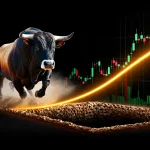Psychological Mastery: The Edge of Great Investors
Jan 5, 2025
The financial arena is often described as a realm of relentless stress, euphoria, and conflict, where fortunes are won and lost in the blink of an eye. Amid the roar of breaking news and the tumult of price fluctuations, one might be tempted to believe that success is purely a function of mathematical acumen or privileged access to cutting-edge data yet if history has taught us anything, true market triumph goes hand in hand with mastery of human psychology—one’s own and that of the masses. The bandwagon effect, mass psychology, and technical analysis intersect daily, forming a web of forces that can trap the unprepared or catapult the resolute to victory. Navigating this interplay with poise and foresight separates true investors from mere speculators.
At first glance, the notion that so many individuals yield to groupthink might seem surprising. After all, markets are now saturated with hyper-intelligent algorithms and trading bots. Nonetheless, even sophisticated tools are designed and guided by humans, with all our cognitive biases and emotional triggers. Fear and greed, panic and ecstasy—these impulses are ancient and universal, time-honoured wellsprings that shape our behaviour in ways we seldom anticipate. Great investors recognize that sound knowledge of mass psychology can unlock hidden value in unpredictable markets. They deploy technical analysis not as a rigid formula but as a prism to interpret the emotional fervour driving price movements.
No one is immune to the primal instincts that arise during extreme volatility. But those who understand and consciously manage these urges place themselves in a position of power; they recognize that panic selling at the bottom or chasing a stock at its euphoric peak is the province of fools. Rather, they exploit the bandwagon effect when it is ripe for reversal, using technical signals to confirm whether a market trend is near exhaustion. The magnitude of success depends, in part, on the discipline to remain calm while everyone else rushes mindlessly toward an apparent safe harbour—or right off a cliff.
The bandwagon effect: how crowds shape prices
One of the most pervasive phenomena in market behaviour is the bandwagon effect. People notice a trend—perhaps a well-known figure touts a hot stock, or headlines trumpet a company’s staggering growth—and jump aboard, often with minimal analysis. The initial wave of enthusiasm may be grounded in rational optimism: strong earnings, new technology, or clear potential for expansion. But as the trend spreads, it takes on a life of its own, emboldening new followers chasing success rather than evaluating fundamentals.
This effect can accelerate exponentially in the digital age. Platforms like social media magnify opinions within echo chambers, reinforcing an illusion of consensus. A hint of positive news circulates online, stoking more buying, which drives the price higher, further confirming that “everyone else is doing it,” so it must be correct. Suddenly, momentum outstrips logic. The same process occurs in reverse when bad news emerges: a whisper of doubt can cascade into panic, culminating in a major sell-off that sends valuations plummeting, sometimes below their true worth.
Understanding the bandwagon effect offers a significant edge. Recognizing that a stock’s popularity often moves faster than its fundamentals is akin to having a map through the chaos. Skilled investors watch how rapidly opinions shift while keeping a cool head. If a stock rallies far beyond what the company’s profits or balance sheet warrant, they might anticipate that euphoria will eventually pivot to realism—or even turn into negativity. Conversely, suppose fear runs rampant in a downturn. In that case, the overshoot to the downside can spawn a fertile field of bargains, overlooked by those too psychologically overwhelmed to see the discrepancy between price and intrinsic value.
Crucially, the bandwagon effect thrives on illusions of certainty. When shares steadily climb, jumping aboard feels natural, especially if everyone else is reaping returns. This is precisely when caution is warranted. Examination of past bubbles—including the dot-com era or the cryptocurrency manias—reveals that groupthink can remain unchecked for extended periods until the facade collapses. The best investors know that timing is everything: they either ride the wave earlier than the latecomers or step aside altogether, waiting to exploit any subsequent price crash. In either case, a keen awareness of how crowds behave is foundational to success.
Mass psychology and the art of contrarian thinking
Mass psychology extends beyond mere bandwagoning. Emotions often intensify within a crowd, feeding a potent group consciousness that can spark a chain reaction of relentless buying or selling. This phenomenon has been observed in moments of extreme crisis: stock market crashes or periods of sudden wariness about systemic failures. Even fundamentally healthy companies can see their stock prices slashed in half because of generalized panic. At these times, the old adage holds especially true—only fools panic during market crashes.
A contrarian approach flourishes in such climates. Contrarian investors deliberately move against the emotional flow of the masses. When most people abandon the ship in terror, contrarians see the seeds of opportunity, provided they remain discerning about a company’s fundamentals. They embrace the chaos, looking for bargains that would be unthinkable in calmer conditions. Historical patterns indicate that rallies often follow crashes as the selling pressure abates and savvy players step in.
At the heart of contrarian success lies the willingness to question prevailing narratives. Mass psychology fosters an environment where negativity breeds negativity or euphoria begets further euphoria. Neither extreme persists indefinitely because, eventually, reality asserts itself. Contrarians who can shed the comfort of popular opinion develop a rare advantage: identifying turning points that elude those blinded by hysteria or collective euphoria. It is not an easy stance to adopt, as it requires swimming against the emotional current of tens of thousands of other market participants. Yet time and again, contrarian investing—rooted in both hard data and a calm reading of psychological trends—proves its worth.
Additionally, contrarian thinking does not imply an unwavering cynicism. Sometimes, following the crowd (perhaps during an early-stage bull market) can be wise. The secret distinguishes between a momentum-driven upswing with legitimate staying power and a mania that outpaces reality. Investors must watch for the early signs of mania: skyrocketing stock valuations without proportionate growth in earnings or revenue or a surge in novice investors flooding into a market sector purely on hype. When these red flags appear in droves, thoughtful contrarians become defensive, hedging positions or shifting to safer assets. Meanwhile, those who cling to illusions typically pay the price when the bubble bursts.
Technical analysis as a guide through psychological storms
Technical analysis (TA) is often depicted as a toolkit of charts, trend lines, and indicators like RSI (Relative Strength Index), MACD (Moving Average Convergence Divergence), and moving averages. On the surface, it may seem purely quantitative—an exercise in crunching price data. However, underlying every candle on a chart is a story of human action: thousands or millions of trades executed by people and algorithms designed by people. Interpreting TA effectively requires awareness of the emotional underpinnings in price action.
When fear spikes, sellers often dominate. Observing the volume accompanying these waves indicates the intensity of the crowd’s sentiment. For instance, an abrupt spike in selling volume might signal capitulation—a point where panic is so extreme that short-term momentum is likely nearing exhaustion. At such moments, bullish divergences in indicators like MACD can convey that, despite the continued drop in price, the downward momentum is weakening. This suggests a potential reversal, which often catches the fearful masses off guard.
Likewise, during periods of exuberance, one might notice rising volume as buyers rush in. If an indicator, such as RSI, repeatedly hits overbought levels, it could signal a looming correction. The euphoria that leads the RSI into extreme territory may pave the way for a short-term pullback—or worse. Skilled investors maintain vigilant self-control, refusing to be pulled into the hype solely because price charts appear unstoppable. They check how daily and weekly charts align, examine whether the bullish momentum is losing steam, and watch for bearish divergences.
Beyond standard indicators, patterns like support and resistance levels reflect collective belief about fair price ranges. A stock that repeatedly bounces off a certain support might indicate strong confidence among buyers, while persistent rejections at resistance reveal that sellers are firmly in control at higher price points. Such patterns emerge from the aggregated psychology of market participants. A trader or investor can glean a richly nuanced perspective by layering these technical insights over fundamental analyses. This synergy often proves crucial in recognizing the subtle cracks in a trend before they become glaringly obvious to the masses.
The synergy of mass psychology and technical analysis
Bringing mass psychology and technical analysis together requires an agile mindset. On the one hand, you have a robust method of interpreting price trends and momentum shifts. Conversely, you understand how the crowd typically behaves in periods of mania or despair. When integrated thoughtfully, these perspectives can provide a comprehensive guide to navigating complex markets.
For instance, suppose a biotech stock experiences a surge in popularity due to a breakthrough medical treatment. Social media ignites, and the bandwagon effect takes hold. The price shoots up, spurred by news coverage and enthusiastic sentiment. Observing social chatter reveals that most participants are retail investors enthralled by hype. Meanwhile, a technical analysis might show a massive gap between the stock’s price and its moving averages. If the RSI is screaming overbought—and there is no follow-up news to justify sustained growth—a prudent investor might suspect the euphoria is reaching its peak. The result could be taking partial profits or employing options strategies to hedge a potential downturn.
Conversely, in a severe market correction, the media churns out dire headlines proclaiming that the end is near. Fear spreads with astonishing speed. Suppose your technical indicators highlight extreme oversold conditions alongside bullish divergences (where indicators rise even as the price still falls). In that case, it might be a powerful clue that the sell-off is overextended. At such inflexion points, only the biggest fools continue panic-selling. By breaking free from groupthink and trusting technical signals and rational analysis, savvy investors can position themselves for the subsequent rebound, reaping the rewards when the tide turns.
Some take this synergy to an even deeper level by incorporating sentiment measures. For example, one might track put-call ratios, short interest, or the flow of investor funds into particular sectors. These metrics serve as proxies for mass psychology, showing real-time data on positioning or conviction. By merging such information with price-based analysis, an investor constructs a holistic picture of the market’s emotional climate. Crucially, the victor in these emotional markets is the one who can remain calm in the face of mania, methodically interpreting signals that others either ignore or misunderstand.
Navigating crashes and seizing opportunities
Market crashes offer a glaring exhibit of how quickly fear can seize the collective imagination. Headlines blared: “Billions lost!” or “This time it’s different—complete collapse looming!” Individuals rush to sell, typically at rock-bottom prices. In these moments, the difference between the wise and the unwise becomes stark. While momentum traders and unseasoned investors jettison their holdings, more discerning minds search for bargains. They examine whether a downturn is a short-term noise or a symptom of something far more lethal.
When the market meltdown of 2008 took hold, for instance, it provoked frantic selling across nearly every sector. True, there were legitimate economic weaknesses, but the indiscriminate nature of the sell-off prompted leading blue-chip companies to become severely undervalued. Those who seized the moment by accumulating the shares of stable enterprises flourished in the ensuing recovery—a similar dynamic played out in 2020, when the pandemic blindsided markets. Investors with the psychological composure to disentangle long-term fundamentals from short-term chaos recognized that specific segments—particularly tech—could endure and grow, even amid lockdowns.
The primary enemy during crashes is not a falling market but the investor’s fear. Panic leads to impulsive decisions, often realized at the worst possible time. This is why it is frequently said, half-jokingly yet with grave seriousness, that only fools panic during collapses. The phrase arises because, historically, panicking leads to locked-in losses and missed opportunities—the double blow that can set one’s portfolio back for years. By combining lessons from mass psychology (recognizing universal fear as an overreaction) with the structural clarity offered by technical analysis (identifying oversold quality stocks or sectors), an investor can deploy capital more confidently. They let the crowd’s emotional frenzy present discounts, effectively profiting from the collective meltdown.
Beyond Panics: from crises to expansions
Psychological mastery is not solely about outperforming others during market meltdowns. It also involves capitalizing on expansions without getting caught in manias. Overconfidence can become a hazard when growth is steady, and markets climb. Somehow, when shares have rallied for months or years, it often seems unimaginable that a downturn could occur. Pride seeps in, fueling the belief that this time is different and the upward trend is unbreakable. Indeed, social proof and headlines touting record highs can lull many into complacency. Ironically, this scenario is just as dangerous as fear-induced selling.
Technical analysis helps keep hubris in check, detecting momentum shifts such as negative MACD crossovers or a series of lower highs in a bullish trend. Combined with reading crowd dynamics, a vigilant investor can sense when exuberance is nearing a fever pitch. It might be the time to tighten stop-loss orders, scale out of positions, or buy put options as insurance. The idea is not to abandon potentially profitable trades prematurely but to adopt a prudent posture, flipping from offence to defence when the storm clouds gather. This balanced approach starkly contrasts those enthralled by illusions of perpetual glory who eventually face rude awakenings.
Moreover, expansions offer an opportunity to refine skills, test new strategies, and reinforce discipline. One can research the cyclical behaviour of various sectors, test how well their technical signals perform, and expand their knowledge base of how mass psychology evolves throughout different market phases. Such preparation ensures that when the next crash arrives, one is psychologically armed and methodically prepared.
Taking control of the mental battlefield
Investing, in essence, is a psychological battlefield. Knowledge of finance, valuation models, and global economic trends provides essential background. But success often hinges on two intangible qualities: emotional discipline and self-awareness. If you fail at either, you become a pawn of the market’s overshadowing groupthink. Recognizing your susceptibility to fear and greed is paramount. Everyone has felt the emotional rush of seeing a surge in share prices or the despair of watching a precipitous decline. The difference comes from managing these emotions constructively rather than letting them dictate decisions.
Meditation, journaling, or reflection on past trades can help refine emotional control. By keeping track of the psychological triggers that led to mistakes—be it panic-selling or chasing overpriced assets—an investor lays the foundation for avoiding similar pitfalls in the future. The market is cyclical, and the same psychological patterns repeat. Thus, self-awareness becomes a potent shield against repeating poor decisions.
Of course, one must also apply rigorous processes to avoid confusion. Combining robust fundamental analysis with technical cues and cross-verifying psychological sentiment crafts a layered safety net. This synergy triggers deeper confidence in selecting assets, reduces the likelihood of knee-jerk reactions, and streamlines exit strategies when the environment looks shaky. The ultimate goal is clarity—seeing through the bandwagon effect’s bombast, mass psychology’s swirl, and the illusions of unstoppable bull runs so that each trade emerges from measured insight rather than raw emotion.
Conclusion
Psychological mastery stands at the core of how great investors consistently win. Technology will continue to evolve, and fresh market catalysts will appear, but the fundamentals of human behaviour are timeless. The bandwagon effect, in which crowds rush to follow an apparent trend, remains an ever-present threat that can mislead novices and experts alike if left unchecked. Mass psychology, with its capacity to sway valuations and create extremes, paralyzes the fearful and emboldens the wise. Meanwhile, technical analysis provides structured insights into how these emotional surges play out in price action, revealing entry and exit points invisible to those blinded by panic or hype.
Fools surrender to terror when markets crash, ignoring the chances lurking behind the headlines. When markets soar, overdosed optimism can push otherwise rational investors into precarious territory. The vigilante combines technical indicators with an unflinching awareness of psychological forces. They do not ignore the crowd’s sentiment; instead, they interpret it, anticipate its shifts, and capitalize on the disconnect between frenzy and fact. The reward lies in turning mass panic into profit and mania into measured gains—all guided by a steady mindset amid the crowd’s clamour.
Such is the path of the sophisticated investor: not one who fears crashes, but one who uses them to discover bargains; not one who rushes into every rally, but one who discerns genuine growth from frothy exuberance. Ultimately, mastery of the market is mastery of oneself—the discipline to observe, evaluate, and act decisively based on insight and logic rather than fear or greed. Such mastery is neither easy nor swift, but it is the bedrock upon which all enduring investment success is built.











